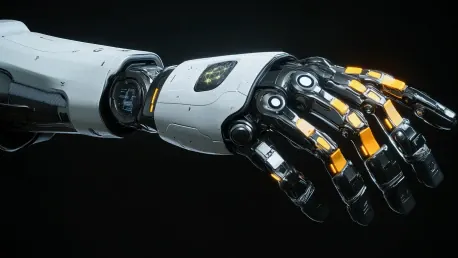Tremors affect approximately 80 million people around the world, significantly impairing their ability to perform everyday tasks. Existing wearable robotic devices have yet to achieve the sophistication needed to provide substantial relief. However, an innovative breakthrough from the collaboration between the Max Planck Institute for Intelligent Systems, University of Tübingen, and University of Stuttgart under Bionic Intelligence Tübingen Stuttgart (BITS) introduces the biorobotic arm as a potential game-changer.
Introducing the Biorobotic Arm
The Mechanical Patient
Researchers have developed a remarkable biorobotic arm, referred to as the “mechanical patient,” that can simulate real tremors by mirroring data recorded from actual patients. This arm is equipped with lightweight artificial muscles—electro-hydraulic actuators known as HASELs—that can contract and relax to counteract tremors. These innovative muscles reduce or almost eliminate visible and felt tremor movements, providing a promising solution for people suffering from conditions such as Parkinson’s disease.
The mechanical patient is not just a groundbreaking piece of technology; it offers a new avenue for developing and testing novel assistive devices without the need for costly and time-consuming clinical trials on human subjects. Researchers can use this biorobotic arm to validate the effectiveness and viability of new assistive technologies in a controlled environment. This allows them to rapidly prototype and refine devices that could one day provide significant relief to patients. By enabling detailed simulations of real tremors, the mechanical patient lays the foundation for a new generation of wearable technologies.
Dual Purpose and Practical Testing
The biorobotic arm serves a dual purpose: it functions both as a research tool and as a testing platform for artificial muscles. Researchers can develop and refine these muscles to ensure they are robust and effective enough for real-world applications. By using the mechanical patient to simulate tremors, scientists can iterate and improve the artificial muscles, which are essential for future wearable devices. This iterative process is crucial for ensuring that these devices are practical and beneficial for end users.
Using the mechanical patient for testing offers several advantages. It provides a safe, ethical, and efficient method for evaluating new technologies without resorting to human trials in the early stages of development. This is particularly important because it allows researchers to overcome ethical and legal challenges associated with early-stage testing on real patients. The ability to conduct rigorous and accurate tests in a controlled environment enables a more streamlined development process and reduces the costs associated with early-stage research and development.
Advantages and Future Potential
Controlled Environment Testing
Conducting tests on the mechanical patient in a controlled environment offers several significant benefits. One major advantage is that it circumvents the ethical and legal challenges of real patient trials. By using the mechanical patient, researchers can avoid the complexities and potential risks involved in testing on humans, especially in the early stages of development. This method also lowers the overall costs of research and development by eliminating the need for early human trials, which are often expensive and time-consuming.
Controlled environment testing also ensures a high degree of consistency and reliability in the results. The mechanical patient can replicate tremor patterns with a high level of accuracy, allowing researchers to evaluate the effectiveness of new technologies under identical conditions. This level of precision is challenging to achieve in human trials due to the variability in patient responses. By using the mechanical patient, researchers can obtain clearer insights into the performance of assistive technologies and make informed decisions about further development and refinement.
Potential for Wearable Devices
One of the most exciting prospects of this research is the potential for creating wearable devices that incorporate HASEL-based artificial muscles. These devices could be discreetly worn by patients, assisting them in performing daily activities that are impaired by tremors. The lightweight and flexible nature of the artificial muscles makes them ideal for integration into garments or other wearable forms, providing a non-intrusive solution for tremor management.
Early tests have demonstrated that HASEL-based muscles are fast and strong enough to address a wide range of tremor intensities, particularly in the wrist. This opens up the possibility of developing versatile wearable devices that can adapt to different levels of tremor severity. As these technologies continue to evolve, the goal is to create practical and user-friendly solutions that can seamlessly integrate into the daily lives of individuals with tremors, significantly improving their quality of life.
Collaborations and Contributions
Expert Involvement
The success of this project is the result of a collaborative effort involving experts from various fields. Alona Shagan Shomron, a postdoc in Robotic Materials, has emphasized the potential of HASEL-based muscles for developing effective wearable devices. Her insights into the properties and capabilities of these artificial muscles have been instrumental in advancing the project. Daniel Häufle, a professor at the Hertie Institute for Clinical Brain Research, has contributed significantly by developing computer simulations and gathering tremor data from patients. This data ensures that the mechanical patient accurately represents real tremors, enhancing the validity of the testing platform.
Another key contributor, Syn Schmitt, a professor of Computational Biophysics and Biorobotics at the University of Stuttgart, has highlighted the cost and time savings achieved by using the mechanical patient for early testing. His expertise in computational models has been vital in optimizing the design and functionality of the biorobotic arm. These collaborative efforts, combining knowledge from robotics, clinical research, and computational modeling, have resulted in a highly effective and efficient research platform.
Innovative Materials
Christoph Keplinger, the Director of the Robotic Materials Department at MPI-IS, underscores the importance of soft robotic systems based on flexible materials in healthcare. The development of HASEL-based artificial muscles is a prime example of how innovative materials can lead to significant advancements in assistive technologies. These muscles are not only lightweight and flexible but also capable of rapid and powerful contractions, making them ideal for applications in wearable devices.
The team’s comprehensive approach provides a robust platform for the rapid evaluation of new tremor suppression technologies. By leveraging the mechanical patient, researchers can conduct thorough assessments at early development stages, accelerating the development of practical solutions. This innovative method could inspire further research and development in the field, leading to better treatment options for those living with tremors. The ability to test and refine technologies in a controlled environment ensures that only the most effective solutions progress to clinical trials.
Practical and Clinical Implications
Non-invasive Solutions
The development of an effective wearable device based on HASEL technology has the potential to revolutionize the management of tremors. Such a device would not only improve the quality of life for those affected but also reduce the burden on healthcare systems. By providing a non-invasive solution that patients can use independently, these wearable devices could significantly enhance daily living for individuals suffering from tremors. The prospect of managing tremors without the need for invasive procedures or constant medical supervision is a game-changer for both patients and healthcare providers.
These wearable devices could facilitate a range of daily activities that are currently challenging for individuals with tremors. Tasks such as drinking from a glass, writing, or using a smartphone could become more manageable, allowing patients to regain a sense of independence. The convenience and user-friendliness of these devices would encourage widespread adoption, ultimately leading to a significant improvement in the overall well-being of people with tremors. The development of non-invasive, effective solutions is a crucial step toward better healthcare outcomes.
Future Innovations in Healthcare
Tremors impact roughly 80 million people globally, severely limiting their ability to perform daily activities. Current wearable robotic devices have not yet reached the level of sophistication necessary to offer significant relief. Yet, a groundbreaking development from a collaboration between the Max Planck Institute for Intelligent Systems, the University of Tübingen, and the University of Stuttgart through Bionic Intelligence Tübingen Stuttgart (BITS) is poised to make a difference. This partnership has introduced the biorobotic arm, a potentially revolutionary device. The biorobotic arm could significantly enhance the quality of life for those afflicted with tremors by providing the much-needed dexterity and stability currently lacking in other available solutions. It aims to offer not only ease in performing everyday tasks but also the promise of independence and improved mental well-being for millions. Such advancements underline the vital role of interdisciplinary research and technology in addressing complex health challenges and improving lives.









